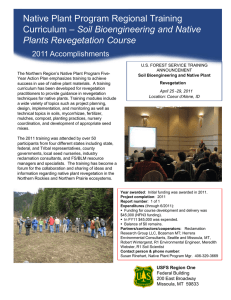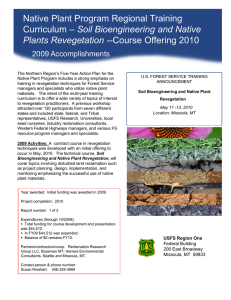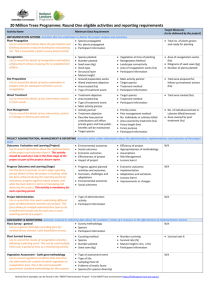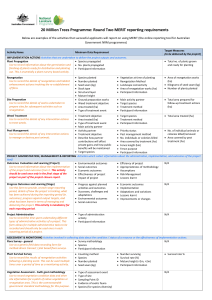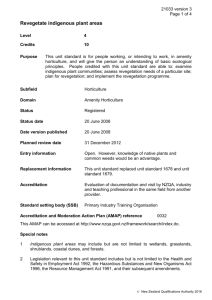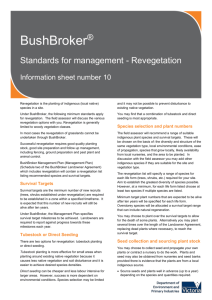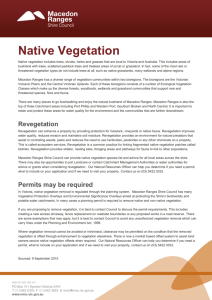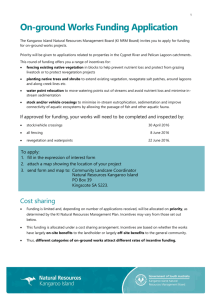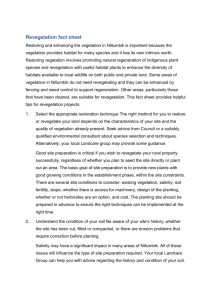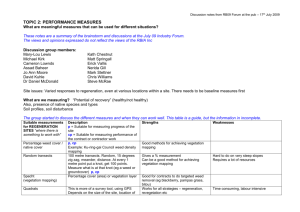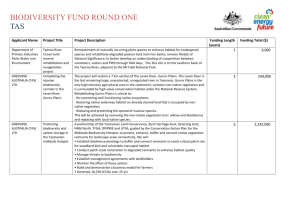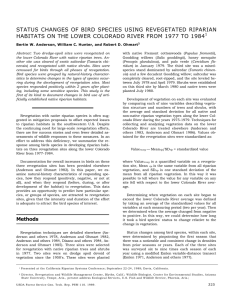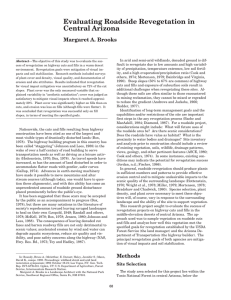Revegetation guidelines for biodiversity
advertisement
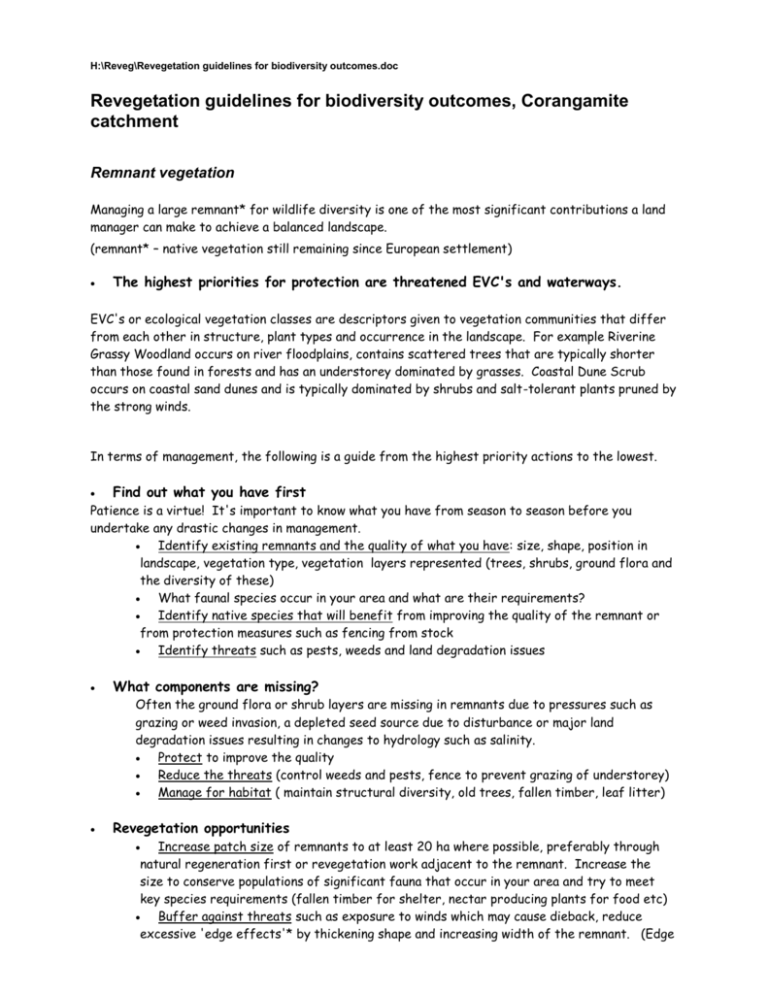
H:\Reveg\Revegetation guidelines for biodiversity outcomes.doc Revegetation guidelines for biodiversity outcomes, Corangamite catchment Remnant vegetation Managing a large remnant* for wildlife diversity is one of the most significant contributions a land manager can make to achieve a balanced landscape. (remnant* – native vegetation still remaining since European settlement) The highest priorities for protection are threatened EVC's and waterways. EVC's or ecological vegetation classes are descriptors given to vegetation communities that differ from each other in structure, plant types and occurrence in the landscape. For example Riverine Grassy Woodland occurs on river floodplains, contains scattered trees that are typically shorter than those found in forests and has an understorey dominated by grasses. Coastal Dune Scrub occurs on coastal sand dunes and is typically dominated by shrubs and salt-tolerant plants pruned by the strong winds. In terms of management, the following is a guide from the highest priority actions to the lowest. Find out what you have first Patience is a virtue! It's important to know what you have from season to season before you undertake any drastic changes in management. Identify existing remnants and the quality of what you have: size, shape, position in landscape, vegetation type, vegetation layers represented (trees, shrubs, ground flora and the diversity of these) What faunal species occur in your area and what are their requirements? Identify native species that will benefit from improving the quality of the remnant or from protection measures such as fencing from stock Identify threats such as pests, weeds and land degradation issues What components are missing? Often the ground flora or shrub layers are missing in remnants due to pressures such as grazing or weed invasion, a depleted seed source due to disturbance or major land degradation issues resulting in changes to hydrology such as salinity. Protect to improve the quality Reduce the threats (control weeds and pests, fence to prevent grazing of understorey) Manage for habitat ( maintain structural diversity, old trees, fallen timber, leaf litter) Revegetation opportunities Increase patch size of remnants to at least 20 ha where possible, preferably through natural regeneration first or revegetation work adjacent to the remnant. Increase the size to conserve populations of significant fauna that occur in your area and try to meet key species requirements (fallen timber for shelter, nectar producing plants for food etc) Buffer against threats such as exposure to winds which may cause dieback, reduce excessive 'edge effects'* by thickening shape and increasing width of the remnant. (Edge effects* such as exposure to weed seed and fertiliser drift impact first at the edge of plant communities and provide opportunities for problems to establish and gradually degrade the remnant.) Connect to other blocks -for maximum wildlife benefit a connection distance < 2km, and corridor width > 50m is preferred. Create stepping stones -create smaller habitat blocks to allow wildlife movement between larger areas Linear strips of revegetation which are often practical for landowners as shelterbelts along waterways and fence lines need to be at least 20 –50m wide to have value for wildlife. Quality of revegetation is important – where possible include all of the structural components (indigenous vegetation layers and logs, rocks etc) that would naturally occur in that area so as to mimic the bones of the EVC. Make the revegetation patchy (not uniform) to provide open feeding areas and clumps for protection. Reduce threatening processes in surrounding landscape eg revegetation for salinity control Revegetation Ensure revegetation is coordinated with other restoration projects in area (for example, Landcare group projects, Catchment Management Authority or Water Authority projects) Use relevant indigenous species and match to landform, soil type and topography Relevant lists can be obtained from local DPI, DSE and CMA staff Include all relevant structural components such as large & small trees, shrubs, grasses. Provide clumps and open space areas and include local growth forms. Seek assistance from agency staff if needed. Maximise the quality through size, shape, connectivity, species selection, landscape position Control threats such as pest plants and animals before you plant. Manage revegetation areas to reduce weed invasion. Suppression of weeds will improve the chances of the revegetated area to succeed and allow natural regeneration with time. Endeavour to plant understorey components over time rather than all in the first year, after you have good weed control and the overstorey plants can provide protection. Plant for different age classes of plants (through planting over a number of years) which helps to meet specific faunal requirements and mimics a more natural landscape. Replenish and restock components including ground flora (seasonal and structural variation) as plant species become available. Plant species in proportions to the natural communities that would have occurred. Typically forests contain 2-5 dominant tree species and many more understorey plants. Most revegetation guides recommend around 30% trees to 70% understorey. Agency staff can assist here. Useful References Geoff Barrett (2000) Birds On Farms – Ecological Management For Agricultural Sustainability Supplement to Wingspan, vol. 10, no. 4, December Birds Australia, Melbourne. Written specifically for land managers and based on results from the Birds on Farms surveys, the booklet outlines ten guidelines for managing farmland to attract birds and improve wildlife outcomes, using data from the five year study. Available from Birds Australia, 415 Riversdale Rd, Hawthorn East 3123 ph: 03 9882 2622 email: mail@birdsaustralia.com.au __________________________________________________________________________ Andrew Bennett, Sally Kimber and Paul Ryan (2000) Revegetation and Wildlife – A Guide to enhancing revegetated habitats for wildlife conservation in rural environments Research Report 2/00. Environment Australia A research report without the technical jargon. This report identifies revegetation practices and principles that will help to maximise wildlife habitat through practical approaches that incorporate revegetation into other farm management activities. Useful planning information is provided from the farm scale to the regional level. Good examples and an extensive reference list are also provided. Download available from Dept Heritage and Environment website under publications. Hardcopies with Landcare Coordinators and DPI revegetation staff within Corangamite catchment. __________________________________________________________________________ Steve Platt (2002) How to Plan Wildlife Landscapes: a guide for community organisations. Department of Natural Resources and Environment, Melbourne. A comprehensive planning tool targeted at local community to help identify and incorporate nature conservation into broader landscape projects. Case studies and useful references included. Available from DSE Information Centre & Bookshop, 8 Nicholson Street, East Melbourne Vic 3002 ph: 9637 8325 email: publication.sales@dse.vic.gov.au NAP Seed Supply and Revegetation Framework Project
